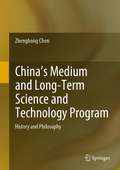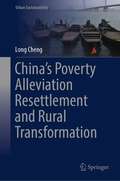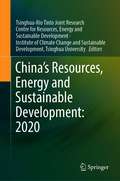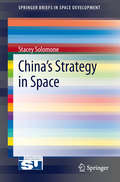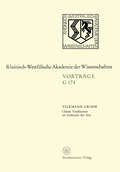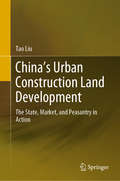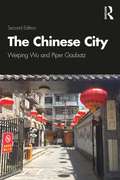- Table View
- List View
China's Grand Strategy: A Framework Analysis
by Honghua MenThis book aims to build the ideal model of China's grand strategy framework, which is based on three key variables: national power, strategic concept and international institution. Taking the rise of China as an opportunity, this book adopts the assessment of national strategic resources as the beginning, focuses on the evaluation of strategic capability, the choice of strategic orientation, the establishment of strategic objectives, the planning of strategic content and the implementation of strategic means. Further, following this main line, this book establishes a China's grand strategy framework based on active participation and integration-transformation-shaping process. This book emphasizes that to achieve the goals of China's grand strategy; China should uphold this strategic attitude: It should not be seduced by praise and should not be made aggressive by criticism. It should learn to be glorious but remain humble, maintain a wealthy, influential but modest position by restraint. This book can be regarded as the essence of the author's 20 years long-term focus and research on the China's grand strategy. The author's postdoctoral tutor Professor Hu Angang’s comment of this book can hit the nail on the head: "This book is a pioneering theoretical study of China's great strategic research and makes a significant contribution to this research field. The basic arguments of this book have been submitted through various approaches to decision-making references or published in academic papers, and have received numerous positive responses and resonance. In my opinion, the basic ideas and important findings of this book will provide imperative reference to long-term strategy decision-making process. In addition, the fundamental theory and analysis method of the book will have an important influence in both domestic and international academic field."
China's Hukou System: Markets, Migrants and Institutional Change
by Jason YoungBy 2010, 260 million citizens were living outside of their permanent hukou location, a major challenge to the constrictive Mao-era system of migration and settlement planning. Jason Young shows how these new forces have been received by the state and documents the process of change and the importance of China's hukou system.
China's Medium and Long-Term Science and Technology Program: History and Philosophy
by Zhenghong ChenThis book conducts a panoramic study on the history of China’s Science and Technology which focuses on the Medium and Long-Term Science and Technology Program (MLSTP). In general these Programs have a duration of 5-30 year. This book provides an epochal assessment of the project’s conceptual context over the past 60 years.. The author shows that the historical evolution and conceptual development of China’s MLSTP are the result of an amalgamation of political, economic and social factors within distinct contemporary contexts. As a national action plan, MLSTP has incorporated many of the factors that go beyond the intentional factors of science and technology. MLSTP is not only a macro vision and blueprint for scientific and technological development; it is also a political act of realizing the national will. While ensuring the MLSTP builds on its great achievements, the author also reflects upon its deficiencies and disadvantages in order to better promote the advancement of science and technology in China.This book comprehensively lays out the historical and theoretical dimensions. Based on a clear vision of historical constructivism the author has compiled the MLSTP philosophy of different eras into a conceptual framework for this era and used this framework to research and analyze the historical and conceptual evolution of MLSTP. Research on MLSTP is important for as enrichment of contemporary studies in the history of science and the science and technology policy. In 2010, more than 60 years after the establishment of the People’s Republic of China, the country had enacted 10 MLSTP programs.This book separates the development of the MLSTP into three different historical eras: the era of economic planning, the era of economic transformation and the new century. Each historical epoch corresponds to a different MLSTP philosophy concept, which enables us to study the conceptual evolution of MLSTP using historical research as our foundation.
China’s New Urbanization: Developmental Paths, Blueprints and Patterns (Springer Geography)
by Chuanglin Fang Danlin YuThis book answers the call for New Urbanization, and proposes a “5+9+6” national spatial layout plan for the urbanization of the 770 major cities in China. This macro pattern is based on a few major metropolises at the center, and other cities supporting and benefitting from these metropolises to form a pyramid-like urban hierarchical system. The book also presents a comprehensive regionalization plan for China’s New Urbanization and strategic approaches to improving the quality of this New Urbanization. Currently, China is aggressively promoting a so-called New Urbanization, which has been regarded as one of the primary ways to build a moderately prosperous society, to address critical issues related to agriculture, rural regions and farmers, to expand domestic demand and promote industrial innovation, and to realize the China Dream. From a systematic perspective and using recently released urban data, the authors analyze the current status of New Urbanization in China and also investigate the various potential problems and obstacles to its concrete implementation. Based on the analyses and investigations, the authors propose strategic directions, paths and basic principles for China’s New Urbanization. In addition, they clearly identify the three different modes of New Urbanization, namely, the general mode, differentiated mode, and gradual mode.Today, many scholars argue that China’s urban regions are experiencing a highly unsustainable mode of development. Chinese cities are heavily burdened by the so-called “urban diseases,” which are characterized e.g. by congested traffic, polluted water and air, and a lack of open and green spaces. Traditional urbanization, which primarily focuses on economic development, must be fundamentally reformed. New Urbanization, which focuses on integrated economic development, social integration and space/environmental sustainability, or simply put, on the quality of urbanization, has been called for to provide a potential “cure” for these urban diseases. Due to the vastness of China’s population and its rapidly growing economic, political and cultural relationships with the rest of the world, the book demonstrates that the success of this New Urbanization is critical not only to the future of urban China, but also the future of urbanization worldwide. The book offers a valuable reference work for all researchers, graduate student and policy makers interested in China’s urban development.
China’s Political System (China Governance System Research Series)
by Ning FangThis book includes collective research by the Institute of Political Science of the Chinese Academy of Social Sciences, which is an important research institution of political science and a think-tank in China. The book was completed by the expert team of "China's Political System" headed by Director Fang Ning for several years and after several changes in their manuscripts.This book covers the core political systems of China, such as the leadership system of the Communist Party of China, the decision-making system of the Party and government in Chinese politics, the system of the people's congress, the relationship between the central and local authorities, the system of officials training and selection, the system of discipline inspection and supervision, the system of consultative democracy and the system of community-level self-governance, etc.This book aims to build a new paradigm of empirical research and introduction of the contemporary Chinese political system by using the description and research method of materialization and dynamics of the political system.
China’s Poverty Alleviation Resettlement and Rural Transformation (Urban Sustainability)
by Long ChengThis book aims to offer a comprehensive understanding of China’s Poverty Alleviation resettlement (PAR) particularly under the Link Policy, and further analysing the impacts of PAR on China’s rural transformation from multiple scales (regional and individual) and perspectives (social-economic development, urban-rural interactions and landscape changes), with a combination of multiple approaches including systematic literature review, content analysis, econometrical methods, spatial analysis, Cellular Automata modelling etc. Policy suggestions will also be provided to improve farmers’ sustainable livelihood and resilience coping with the changes of lifestyles due to the resettlement. This book contributes to inspiring and provoking thought among policymakers, researchers, and individuals worldwide grappling with the pressing issue of poverty and its eradication. Understanding the Chinese experience may yield valuable insights that can be adapted and applied in diverse contexts around the globe.
China’s Resources, Energy and Sustainable Development: 2020
by Tsinghua-Rio Tinto Joint Research Centre for Resources, Energy and Sustainable Development Institute of Climate Change and Sustainable Development, Tsinghua UniversityThis book explores sustainable development from the perspective of resources and energy, based on China’s practical experience and cross-disciplinary research. It focuses on major challenges, key solutions and policy recommendations, and studies and explores seven important themes of resources, energy and sustainable development, including: 1) China’s low-carbon energy transition, 2) China’s urbanization and low-carbon development, 3) China’s low-carbon action in cities, 4) China’s low-carbon power transition, 5) China’s water resources management, 6) electric vehicle development and key metal resources and 7) China’s low-carbon development of the iron & steel industry. This book contributes to a more integrated understanding of many themes and their relationships in the area of resources, energy and sustainable development and guides the related policy and management.
China’s Role in Reducing Carbon Emissions: The Stabilisation of Energy Consumption and the Deployment of Renewable Energy
by David TokeChina, a still developing economy comprising a fifth of the world’s population, will play a key role in the global movement towards reducing carbon emissions. The aims of the Paris Agreement may stand or fall with China, both for its own contribution and the example it will set the developing world. China’s Role in Reducing Carbon Emissions discusses the prospects for China achieving radical reductions in carbon emissions, within the context of the current economic and political landscape. With a particular focus on technologies such as such as wind power, solar power and electric vehicles, Toke examines how China is transitioning to a state of stable energy consumption via a service-based economy and heavy investment in non-fossil energy sources. The book concludes that China may be set to reduce its carbon emissions by approximately two-thirds by 2050. This book is a valuable resource for students and scholars of climate change, sustainable development, political science and energy, as well as energy professionals seeking to understand the implications of recent developments in China.
China’s Role in Reducing Carbon Emissions: The Stabilisation of Energy Consumption and the Deployment of Renewable Energy
by David TokeChina, a still developing economy comprising a fifth of the world’s population, will play a key role in the global movement towards reducing carbon emissions. The aims of the Paris Agreement may stand or fall with China, both for its own contribution and the example it will set the developing world. China’s Role in Reducing Carbon Emissions discusses the prospects for China achieving radical reductions in carbon emissions, within the context of the current economic and political landscape. With a particular focus on technologies such as such as wind power, solar power and electric vehicles, Toke examines how China is transitioning to a state of stable energy consumption via a service-based economy and heavy investment in non-fossil energy sources. The book concludes that China may be set to reduce its carbon emissions by approximately two-thirds by 2050. This book is a valuable resource for students and scholars of climate change, sustainable development, political science and energy, as well as energy professionals seeking to understand the implications of recent developments in China.
China's Rural Market Development in the Reform Era
by Him ChungThe rural market in China is not only the venue where 60 per cent of the country's 1.3 billion inhabitants buy their daily necessities and sell agricultural products, but also a key area of conflict between government control and liberalization policies. Previous research on the topic has adopted a purely economic perspective, focusing on macro issues such as price control and grain procurement. This book focuses instead on peasants - the major participants in rural marketing activities. Illustrated by two comparative case studies with a diverse level of development from the Pearl River Delta - one of the most prosperous regions in coastal China - this book investigates the market hierarchy, its change of functions and the interactions between peasants and market outlets. In doing so, it shows how China's rural market district has changed since the Reform, and how these changes affect the marketing activities of peasants.
China's Rural Market Development in the Reform Era
by Him ChungThe rural market in China is not only the venue where 60 per cent of the country's 1.3 billion inhabitants buy their daily necessities and sell agricultural products, but also a key area of conflict between government control and liberalization policies. Previous research on the topic has adopted a purely economic perspective, focusing on macro issues such as price control and grain procurement. This book focuses instead on peasants - the major participants in rural marketing activities. Illustrated by two comparative case studies with a diverse level of development from the Pearl River Delta - one of the most prosperous regions in coastal China - this book investigates the market hierarchy, its change of functions and the interactions between peasants and market outlets. In doing so, it shows how China's rural market district has changed since the Reform, and how these changes affect the marketing activities of peasants.
China's Soil Pollution and Degradation Problems
by Claudio O. DelangChina’s air pollution is infamous. The haze can make it impossible to see buildings across the street, and the pollution forces schools to close and creates health and morbidity problems, in addition to tremendous environmental degradation. However, China also faces another important environmental problem, which is less well-known to the public: that of soil degradation and pollution. This book provides an overview of the problems related to soil degradation and pollution throughout China, examining how and why current policy has fallen short of expectation. It also examines the challenges faced by policy makers as they attempt to adopt sustainable practices alongside a booming and ever-expanding economy. China's Soil Pollution and Degradation Problems utilizes grey literature such as newspaper articles, NGO reports and Chinese government information alongside academic studies in order to provide an extensive review of the challenges faced by grassroots organizations as they tackle environmental policy failings throughout China. This book will be of great interest to students of environmental pollution and contemporary Chinese studies looking for an introduction to the topics of soil pollution and soil degradation, and for researchers looking for an extensive list of sources and analysis of China's environmental problems more broadly.
China's Soil Pollution and Degradation Problems
by Claudio O. DelangChina’s air pollution is infamous. The haze can make it impossible to see buildings across the street, and the pollution forces schools to close and creates health and morbidity problems, in addition to tremendous environmental degradation. However, China also faces another important environmental problem, which is less well-known to the public: that of soil degradation and pollution. This book provides an overview of the problems related to soil degradation and pollution throughout China, examining how and why current policy has fallen short of expectation. It also examines the challenges faced by policy makers as they attempt to adopt sustainable practices alongside a booming and ever-expanding economy. China's Soil Pollution and Degradation Problems utilizes grey literature such as newspaper articles, NGO reports and Chinese government information alongside academic studies in order to provide an extensive review of the challenges faced by grassroots organizations as they tackle environmental policy failings throughout China. This book will be of great interest to students of environmental pollution and contemporary Chinese studies looking for an introduction to the topics of soil pollution and soil degradation, and for researchers looking for an extensive list of sources and analysis of China's environmental problems more broadly.
China’s Strategy in Space (SpringerBriefs in Space Development)
by Stacey SolomoneThis book addresses why China is going into space and provides up- to-date information on all aspects of the Chinese Space Program in terms of launch vehicles, launch sites and infrastructure, crew vehicles for space exploration, satellite applications and scientific exploration capabilities. Beyond mere capabilities, it is important to understand how Chinese aerospace leaders think, how they make decisions, and what their ultimate goal is during their space endeavors. What are Chinese intentions in space? To what extent does culture and ethics influence Chinese strategic decision-making within the highest levels of the aerospace industrial complex? This book examines these questions and offers four potential scenarios on where the Chinese space program is headed based on this new perspective of understanding China’s space goals. This book is not only required reading for policy makers and military leaders in the US government, but also for the general population, students, and professionals interested in truly understanding the reasons behind what the Chinese are doing in space.
Chinas Traditionen im Umbruch der Zeit: Gemeinsame Sitzung der Klasse für Geisteswissenschaften und der Klasse für Natur-, Ingenieur- und Wirtschaftswissenschaften am 23. September 1970 in Düsseldorf (Rheinisch-Westfälische Akademie der Wissenschaften #174)
by Tilemann GrimmChina’s Transition on Climate Change Communication and Governance: From Zero to Hero (Research Series on the Chinese Dream and China’s Development Path)
by Binbin WangThis book provides a two-level analytical framework and empirical study to analyze the reason and process of China’s transition that is from a follower to driver in the field of global climate governance, and is especially valuable the dialogues and cooperation between the government, media and civil society. Nowadays, China shows strong leadership to push the process of global climate governance. It’s the first and fastest time in the past 40-year history of China’s Opening-up that China wins the international respect and trust in one of the issues of global governance. What experiences can be summarized? What dynamic situations and new possibilities emerged after Trump, the U.S. president announced to withdraw from the Paris Agreement? How to move forward based on the existing success? This timely book offers new lens for international readers to understand China’s effort domestically and internationally in the field of climate change and illustrate the outlook of the climate governance in the frame of win-win co-governance model.
China’s Urban Agglomerations (Springer Geography)
by Chuanglin Fang Danlin YuThe book combs through extensively 32,231 urban agglomeration related works during the past 120 years to explore a theoretically supported and practically based definition of urban agglomeration. Based on the definition, the authors explore intensively the fundamental characteristics, spatiotemporal differentiation properties, and existing issues for China’s sustainable urban agglomeration development for the past 35 years. The study proposes that China shall focus on the construction and sustainable development of five primary national-level urban agglomerations. In the meantime, China shall also steadily and gradually construct 9 regional urban agglomerations and guide the development and growth of 6 local urban agglomerations. In the long run, China will have a hierarchical “5+9+6” closely integrated hierarchical urban agglomeration spatial structure. The study also proposes to coordinate the construction and development of urban agglomerations on the “two belts and one road” to form a national new urbanization development strategic pattern that enables “the axis to connect the agglomerations while the agglomerations support the axis.” Furthermore, the study investigates a variety of strategic thinking and suggestions for creating innovative, green and ecologically friendly, intelligent, low-carbon, open, culture-oriented, market-oriented and shared urban agglomerations in China. This book will be a comprehensive reference both for scholars and decision-makers engaged in urban development and planning and environmental protection departments. It can also serve as textbook for graduate students of relevant fields.
China’s Urban Construction Land Development: The State, Market, and Peasantry in Action
by Tao LiuThis book examines the nature and internal dynamics of China’s urban construction land (UCL) development, drawing insights from the recently developed theory of regional political ecology. Based on the author’s original research, it identifies two different types of UCL development in China, namely top-down, formal development in the legal and regulated domain, and spontaneous and informal, bottom-up development in the semi-legal, poorly regulated gray domain. Presenting a systematic analysis and comparison, it reveals a scale and speed of informal land development no less significant than that of formal land development, although informal land development tends to be scattered, pervasive, difficult to track, and largely overlooked in research and policy formation. Contrary to the popular perception of the peasantry as passive victims of land development, this book uncovers an intriguing dynamic in which the peasantry has played an increasingly (pro)active role in developing their rural land for urban uses in informal markets. Further, based on an investigation of UCL development in Beijing and Shenzhen, it shows an interesting trajectory in which the uneven growth and utilization of UCL are contingent upon the various developmental milieus in different places. China’s land institutions, based on an urban–rural dual land system, are not conducive to the ultimate goal of saving and efficiently utilizing land. Accordingly, an urban–rural integrated land market and management system is highly advisable. The theoretical and empirical enquiry presented challenges the perceived notion of China’s UCL development as the outcome of market demand and state supply. Further, it argues for an inclusive treatment of the informality that has characterized urbanization in many developing countries, and for a reassessment of the role played by the peasantry in land-based urbanization.
China's Urban Pattern (Springer Geography)
by Chuanglin Fang Danlin Yu Hanying Mao Chao Bao Jinchuan HuangThe book embarks on the tasks to systematically analyze the macro background of the spatial patterns of China’s urban development, the theoretical foundations and framework, and its changing trajectory. From a quantitative perspective, we attempt to evaluate the rationale behind the spatial patterns of China’s urban development and systematically simulate the various scenarios. From the simulation results, we propose the optimizing goals, priorities, models, and strategies for the spatial patterns of China’s urban development. The work in this book attempts to provide constructive suggestions and potential strategies to support the effort to optimize the spatial patterns of China’s urban development. It would be a valuable reference for planning departments, development and reform committees, and science and technology administrative departments at various governmental levels. It could also be a valuable addition to graduate students of urban planning, urban development, urban geography and relevant disciplines.
China's Water Pollution Problems
by Claudio O. DelangWater pollution is one of the most serious problems plaguing China today with millions of citizens drinking water unfit for consumption. These abysmal conditions have fuelled increasing social discontent, as people become more concerned by the need to address the pressing issues of water pollution, scarcity, and waste management. This book describes how and why China has ended up in such a dire situation, what the government is doing to address the problem and the difficulties encountered in attempting to reduce pollution. The analysis is based on both gray literature (newspaper articles, NGO reports, Chinese government information) and on academic studies. The gray literature gives a voice to those who suffer from the pollution, their advocates, and government officers, and allows the reader to better grasp the conditions on the ground, and the impact of the air pollution among the people in different areas in China. The academic literature adds a theoretical perspective and brings these different case studies into a broader context. This book will be of great interest to students of environmental pollution and contemporary Chinese studies looking for an introduction to the topic, as well as researchers looking for an analysis of China's environmental problems.
China's Water Pollution Problems
by Claudio O. DelangWater pollution is one of the most serious problems plaguing China today with millions of citizens drinking water unfit for consumption. These abysmal conditions have fuelled increasing social discontent, as people become more concerned by the need to address the pressing issues of water pollution, scarcity, and waste management. This book describes how and why China has ended up in such a dire situation, what the government is doing to address the problem and the difficulties encountered in attempting to reduce pollution. The analysis is based on both gray literature (newspaper articles, NGO reports, Chinese government information) and on academic studies. The gray literature gives a voice to those who suffer from the pollution, their advocates, and government officers, and allows the reader to better grasp the conditions on the ground, and the impact of the air pollution among the people in different areas in China. The academic literature adds a theoretical perspective and brings these different case studies into a broader context. This book will be of great interest to students of environmental pollution and contemporary Chinese studies looking for an introduction to the topic, as well as researchers looking for an analysis of China's environmental problems.
China's Water Resources Management: A Long March to Sustainability
by Seungho LeeThis book investigates water resources management and policy in China over the last two decades with a core focus on the role of water for socioeconomic development and sustainability. Recent policies, such as the Three Red Lines and the Water Ten Plan are evaluated for sustainable water supply, use and quality control. The book appraises solutions through demand management, water rights and pollution trading, virtual water and water footprint. Supply management is discussed taking examples from the Three Gorges Dam and the South North Water Transfer Project. The water market is investigated uncovering the active engagement of the private sector and includes discussions on how transboundary rivers demonstrate China’s engagement with its riparian countries for benefit sharing. This book will be an invaluable reference for researchers in the field as well as practitioners and students who have an interest in water and development in China.
CHINA EDITION - Sustainable Champions: How International Companies are Changing the Face of Business in China
by Fu Jia Jonathan Gosling Morgen WitzelIn the face of strong competitive pressure and a dynamic market, multinational companies in China are forced to innovate with extraordinary pace and inventiveness. Environmental sustainability is a vital benchmark, and is a key driver for the best companies in each sector – many of them allied with the WWF Climate Savers programme. Sustainable Champions shows how nine leading multinational companies - including Nestlé, HP, Tetra Pak and Sony - are dealing with environmental, supply chain and ethical challenges in China. The book illuminates some of their transformative practices, and the impact this is having on business in China and beyond. The concluding cross-case analysis of supply chain and environmental challenges faced by leading international firms presents key lessons for business and for sustainability champions. Sustainable Champions: How International Companies are Changing the Face of Business in China is essential reading for researchers and course leaders seeking on-the-ground examples of local environmental challenges, and any company doing business in one of the world’s fastest-growing economies. With a Foreword by Simon Zadek, Distinguished Fellow, Academy of Business in Society, Visiting Scholar, Tsinghua School of Economics and Management.
The Chinese City
by Weiping Wu Piper GaubatzDrawing on years of research experience and keen observations of the triumphs and problems in China’s cities, the authors provide a foundational understanding of China’s urbanization and cities that is grounded in history and geography and challenges readers to consider Chinese urbanization through multiple disciplinary and thematic lenses. This book is anchored in the spatial sciences, including geography, urban studies, urban planning, and environmental studies. It offers a comprehensive survey of the evolving urban landscape, covering such topics as history and patterns of urbanization, spatial and regional context, models of urban form, economic and social-spatial transformation, urbanism and cultural dynamics, housing and land development, environmental and infrastructure issues, poverty and inequality, and challenges of urban governance. The book highlights both parallels and substantive differences between China and comparable cities and countries elsewhere, given that some urban conditions around the world converge and point to shared catalysts (e.g. internal migration) and globally linked processes (e.g. climate change). It explores the consequences of the demographic, economic, social, and environmental transitions on cities and urban dwellers. Illustrated case studies in each chapter ground the discussion and introduce readers to the diversity of cities and urban life in China. Most chapters also can be used as stand-alone course materials, with suggested references for further reading. Intended for a wide audience in higher education and beyond, this book will be useful to readers interested in Chinese Studies, East Asian Studies, Urban Studies, Urban Geography, or Urban Planning.
The Chinese City (A\world Bank Publication)
by Weiping Wu Piper GaubatzDrawing on years of research experience and keen observations of the triumphs and problems in China’s cities, the authors provide a foundational understanding of China’s urbanization and cities that is grounded in history and geography and challenges readers to consider Chinese urbanization through multiple disciplinary and thematic lenses. This book is anchored in the spatial sciences, including geography, urban studies, urban planning, and environmental studies. It offers a comprehensive survey of the evolving urban landscape, covering such topics as history and patterns of urbanization, spatial and regional context, models of urban form, economic and social-spatial transformation, urbanism and cultural dynamics, housing and land development, environmental and infrastructure issues, poverty and inequality, and challenges of urban governance. The book highlights both parallels and substantive differences between China and comparable cities and countries elsewhere, given that some urban conditions around the world converge and point to shared catalysts (e.g. internal migration) and globally linked processes (e.g. climate change). It explores the consequences of the demographic, economic, social, and environmental transitions on cities and urban dwellers. Illustrated case studies in each chapter ground the discussion and introduce readers to the diversity of cities and urban life in China. Most chapters also can be used as stand-alone course materials, with suggested references for further reading. Intended for a wide audience in higher education and beyond, this book will be useful to readers interested in Chinese Studies, East Asian Studies, Urban Studies, Urban Geography, or Urban Planning.


